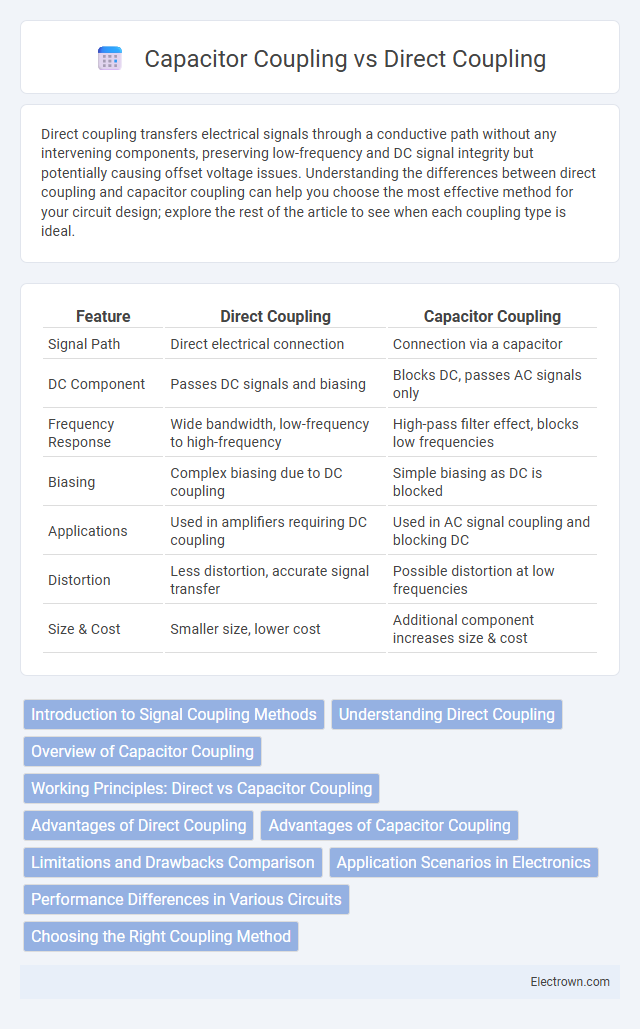Direct coupling transfers electrical signals through a conductive path without any intervening components, preserving low-frequency and DC signal integrity but potentially causing offset voltage issues. Understanding the differences between direct coupling and capacitor coupling can help you choose the most effective method for your circuit design; explore the rest of the article to see when each coupling type is ideal.
Table of Comparison
| Feature | Direct Coupling | Capacitor Coupling |
|---|---|---|
| Signal Path | Direct electrical connection | Connection via a capacitor |
| DC Component | Passes DC signals and biasing | Blocks DC, passes AC signals only |
| Frequency Response | Wide bandwidth, low-frequency to high-frequency | High-pass filter effect, blocks low frequencies |
| Biasing | Complex biasing due to DC coupling | Simple biasing as DC is blocked |
| Applications | Used in amplifiers requiring DC coupling | Used in AC signal coupling and blocking DC |
| Distortion | Less distortion, accurate signal transfer | Possible distortion at low frequencies |
| Size & Cost | Smaller size, lower cost | Additional component increases size & cost |
Introduction to Signal Coupling Methods
Direct coupling involves connecting circuit stages without any intermediate components, allowing low-frequency and DC signals to pass through unaltered, which is crucial in amplifier design for preserving signal integrity. Capacitor coupling uses capacitors to block DC components while allowing AC signals to pass, making it ideal for separating stages that operate at different DC bias levels. Both methods are fundamental in electronic signal transmission, each optimizing performance based on frequency response and circuit requirements.
Understanding Direct Coupling
Direct coupling connects circuit stages without intervening components, allowing both AC and DC signals to pass freely and preserving low-frequency signals and DC bias levels. This approach is crucial in amplifiers that require faithful reproduction of input signals, including DC components, to maintain accurate signal integrity. Your choice of direct coupling ensures minimal signal distortion and seamless signal transfer across stages, especially in low-frequency or DC applications.
Overview of Capacitor Coupling
Capacitor coupling involves connecting two circuits through a capacitor, allowing AC signals to pass while blocking DC components. This method is essential for isolating DC biases between stages in amplifiers, preserving signal integrity and preventing damage. Capacitor coupling is preferred in audio and radio frequency applications due to its frequency-selective properties and minimal distortion.
Working Principles: Direct vs Capacitor Coupling
Direct coupling transmits signals through a continuous conductive path, allowing both AC and DC components to pass uninterrupted, which is ideal for amplifying low-frequency or DC signals. Capacitor coupling blocks DC components by passing only AC signals through a coupling capacitor, preventing DC bias shifts between stages but limiting low-frequency response. Your choice depends on the need to preserve DC levels (direct coupling) or isolate DC voltages between circuit stages (capacitor coupling).
Advantages of Direct Coupling
Direct coupling offers seamless signal transmission without frequency limitation, making it ideal for amplifying low-frequency or DC signals. Your circuits benefit from improved linearity and reduced signal distortion since direct coupling eliminates the insertion loss and phase shift caused by capacitors. This coupling method also simplifies the design by reducing component count and power consumption, enhancing overall system reliability.
Advantages of Capacitor Coupling
Capacitor coupling offers superior isolation between circuit stages by blocking DC components and allowing only AC signals to pass, preventing unwanted bias shifts. This enables flexible design adjustments in multi-stage amplifiers without affecting operating points. Moreover, capacitor coupling reduces distortion and protects sensitive components from DC damage, enhancing overall circuit reliability and performance.
Limitations and Drawbacks Comparison
Direct coupling suffers from DC offset and drift issues, making it unsuitable for circuits requiring stable zero-level signals, while capacitor coupling blocks DC components but introduces low-frequency signal attenuation due to the capacitive reactance. The inability of direct coupling to isolate signal stages can lead to noise amplification and biasing complications, whereas capacitor coupling can cause phase distortion and transient response problems at signal boundaries. Your design choice depends on balancing low-frequency response needs against stability and noise considerations inherent in each coupling method.
Application Scenarios in Electronics
Direct coupling is commonly used in amplifier circuits where signal integrity and low-frequency response are critical, such as in audio amplifiers and operational amplifiers. Capacitor coupling is preferred in applications requiring isolation between stages to block DC components while allowing AC signals to pass, including radio frequency circuits and signal processing units. Selecting between direct and capacitor coupling depends on factors like frequency response, signal distortion, and circuit impedance characteristics.
Performance Differences in Various Circuits
Direct coupling offers superior low-frequency performance and zero signal distortion, making it ideal for DC amplifiers and operational amplifier circuits requiring accurate signal reproduction. Capacitor coupling blocks DC components, effectively preventing bias shifts but introduces frequency-dependent attenuation and phase shift, which can degrade performance in low-frequency or audio circuits. In high-frequency circuits, capacitor coupling minimizes DC offset issues while maintaining signal integrity, whereas direct coupling may cause drift and instability due to DC offsets.
Choosing the Right Coupling Method
Choosing the right coupling method depends on signal frequency, impedance levels, and application requirements. Direct coupling provides a low-frequency response and DC signal transfer, ideal for amplifiers and active devices, while capacitor coupling blocks DC components and passes AC signals, suitable for audio and RF circuits. Proper selection ensures signal integrity, minimizes distortion, and matches circuit impedance for optimal performance.
direct coupling vs capacitor coupling Infographic

 electrown.com
electrown.com